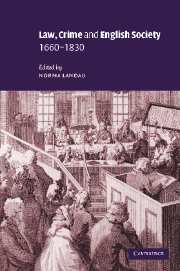Book contents
- Frontmatter
- Contents
- List of figures
- Notes of contributors
- 1 Introduction
- Part 1 Law
- Part 2 Crime
- 5 War as a judicial resource. Press gangs and prosecution rates, 1740–1830
- 6 Making the ‘bloody code’? Forgery legislation in eighteenth-century England
- 7 Mapping criminal law: Blackstone and the categories of English jurisprudence
- Part 3 Society
- John M. Beattie's publications
- Index
5 - War as a judicial resource. Press gangs and prosecution rates, 1740–1830
from Part 2 - Crime
Published online by Cambridge University Press: 30 June 2009
- Frontmatter
- Contents
- List of figures
- Notes of contributors
- 1 Introduction
- Part 1 Law
- Part 2 Crime
- 5 War as a judicial resource. Press gangs and prosecution rates, 1740–1830
- 6 Making the ‘bloody code’? Forgery legislation in eighteenth-century England
- 7 Mapping criminal law: Blackstone and the categories of English jurisprudence
- Part 3 Society
- John M. Beattie's publications
- Index
Summary
The paradoxical relationship between war and crime was well understood by the propertied classes of eighteenth-century England. ‘The appearance of war is a present safety to the public’, The Times announced in the early 1790s. ‘Press gangs are better magistrates than the Middlesex justices.’ In eighteenth-century England, which usually succeeded in exporting its military conflicts, war meant peace and peace meant problems for those responsible for the protection of property.
As historical work on the eighteenth century's nearest equivalent to a recorded crime index (i.e. property crime indictment rates) began in earnest in the 1970s, the intimate relationship between war/peace transitions and recorded crime gradually emerged as an important theme – most notably in the work of John Beattie and Douglas Hay but also in a number of other county studies. A distinctive and fairly consistent pattern emerged from this research. In virtually every area studied the outbreak of war led to a reduction in indictments while the coming of peace increased them. On average peacetime indictment rates were over a third higher than wartime ones – a pattern only broken in a few years of either peacetime recruitment (e.g. 1770–1) or exceptionally bad wartime harvests (e.g. 1740–1, 1800–1).
In attempting to explain this pattern historians have briefly explored some of the potential effects of mobilization and armed forces recruitment, but they have mainly focused on the impact of demobilization.
- Type
- Chapter
- Information
- Law, Crime and English Society, 1660–1830 , pp. 97 - 116Publisher: Cambridge University PressPrint publication year: 2002
- 2
- Cited by



